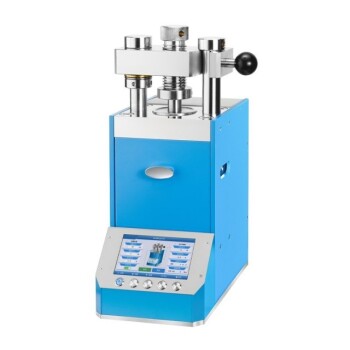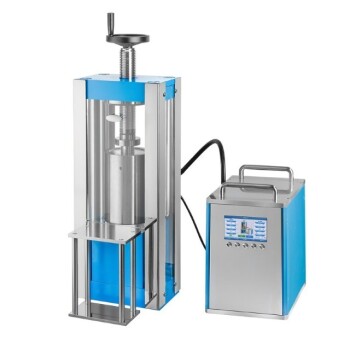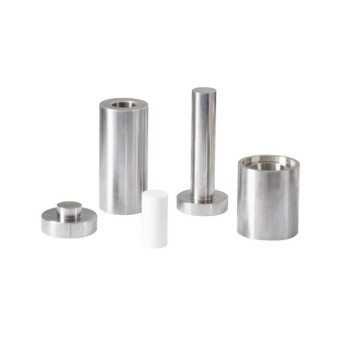In pharmaceutical research, the primary benefit of a hydraulic press is its ability to deliver exceptionally precise and repeatable force. This capability is not just a convenience; it is fundamental to the core R&D tasks of creating uniform drug tablets and conducting reliable dissolution testing, ensuring both product quality and the validity of experimental outcomes.
The true value of a hydraulic press in a lab setting is its translation of a simple physical principle—hydraulic force—into a cornerstone of scientific validity. It provides the controlled, consistent pressure required to produce uniform samples and test them reliably, which is non-negotiable for drug development and quality control.
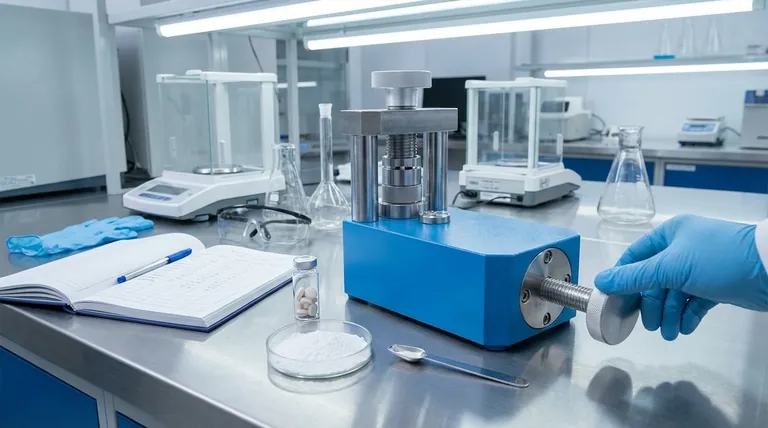
The Core Principle: Why Controlled Force is Critical
The function of a hydraulic press is based on a straightforward principle, but its implications for pharmaceutical research are profound. It allows a small amount of input effort to be converted into a significant, highly controllable output force.
Unmatched Force Amplification
A hydraulic system multiplies force, enabling a compact machine to generate immense pressure, often multiple tons. This allows researchers to compact powders into solid tablets or stress materials without requiring bulky or energy-intensive equipment.
Absolute Precision and Control
Modern hydraulic presses, especially those designed for labs, include accurate pressure gauges. This allows an operator to dial in and apply a specific, targeted amount of force, ensuring that the pressure itself is a known and controlled variable in any experiment.
Guaranteed Repeatability for Validated Results
Once a pressure setting is established, a hydraulic press can replicate it exactly across dozens or hundreds of samples. This repeatability is the bedrock of quality control, eliminating pressure variations as a source of error when comparing the properties of different drug formulations.
Key Applications in Pharmaceutical Development
While a hydraulic press is a versatile tool, it excels in several specific tasks that are central to the pharmaceutical lifecycle, from initial formulation to final quality assurance.
Tablet Manufacturing and Formulation
Creating a uniform tablet is critical for ensuring a consistent dose and predictable dissolution rate. A hydraulic press applies even pressure across the die, compacting the powdered active ingredients and excipients into a solid tablet with uniform density and hardness. This is essential for early-stage formulation development.
Dissolution Testing and Bioavailability
Dissolution testing simulates how a drug will break down in the body. A press is used to apply specific mechanical stress to the tablet, which helps in analyzing its structural integrity, breakdown rate, and the subsequent release of its active pharmaceutical ingredient (API). This data is vital for predicting a drug's efficacy.
Advanced Sample Preparation with Heat
Many lab presses are heated hydraulic presses, combining precise force with temperature control. This is indispensable for more advanced applications like drug encapsulation, where an API is enclosed within a polymer. The controlled heat and pressure ensure the integrity of the encapsulation, which directly impacts the drug's bioavailability and delivery mechanism.
Understanding the Practical Advantages and Trade-offs
Beyond its scientific applications, the hydraulic press offers operational benefits that make it a cost-effective and safe choice for the modern lab. However, it's important to understand its context.
Efficiency and Low Maintenance
Hydraulic systems are mechanically simple, with few moving parts. This results in high reliability and minimal maintenance requirements, lowering the total cost of ownership over the equipment's lifespan.
Operator and Equipment Safety
Laboratory-grade presses are designed with safety as a priority. They often include safety shields and overload protection mechanisms that prevent the system from being operated beyond its rated tonnage, protecting both the user and the instrument.
Versatility vs. Scale
A lab-scale hydraulic press is incredibly versatile for R&D, capable of handling tablet making, material testing, and polymer forming. It is not, however, a replacement for a dedicated rotary tablet press used in high-volume manufacturing. Its strength is in research, not mass production.
The Consideration of Space
For labs where bench space is at a premium, a hydraulic mini-press is an ideal solution. These compact units are lightweight and portable but can still generate up to two tons of force, providing significant capability in a small footprint.
Making the Right Choice for Your Goal
Selecting the right press depends entirely on your lab's primary research objectives.
- If your primary focus is early-stage formulation and batch testing: A compact mini-press with an accurate gauge provides the necessary control and repeatability for creating and analyzing small sample sets.
- If your primary focus is developing novel drug delivery systems: A heated hydraulic press is non-negotiable for working with polymers, thin films, and encapsulation techniques.
- If your primary focus is establishing robust quality control protocols: The most critical feature is a press with a highly accurate and calibrated pressure gauge to ensure your test results are validated and repeatable.
Ultimately, integrating the right hydraulic press into your workflow provides a foundation of control and consistency for your research.
Summary Table:
| Benefit | Description |
|---|---|
| Precise Force Control | Enables exact pressure application for uniform tablet density and hardness. |
| Repeatability | Ensures consistent results across samples, vital for quality control. |
| Versatility | Supports tablet manufacturing, dissolution testing, and heated applications like encapsulation. |
| Safety | Includes shields and overload protection for operator and equipment safety. |
| Efficiency | Low maintenance and reliable, reducing total cost of ownership. |
Ready to enhance your pharmaceutical R&D with reliable hydraulic presses? KINTEK specializes in lab press machines, including automatic lab presses, isostatic presses, and heated lab presses, designed to deliver precise force control, repeatability, and safety for your laboratory needs. Whether you're developing new drug formulations or ensuring quality control, our equipment supports your goals with efficiency and accuracy. Contact us today to discuss how we can help optimize your research processes and achieve consistent, validated results!
Visual Guide
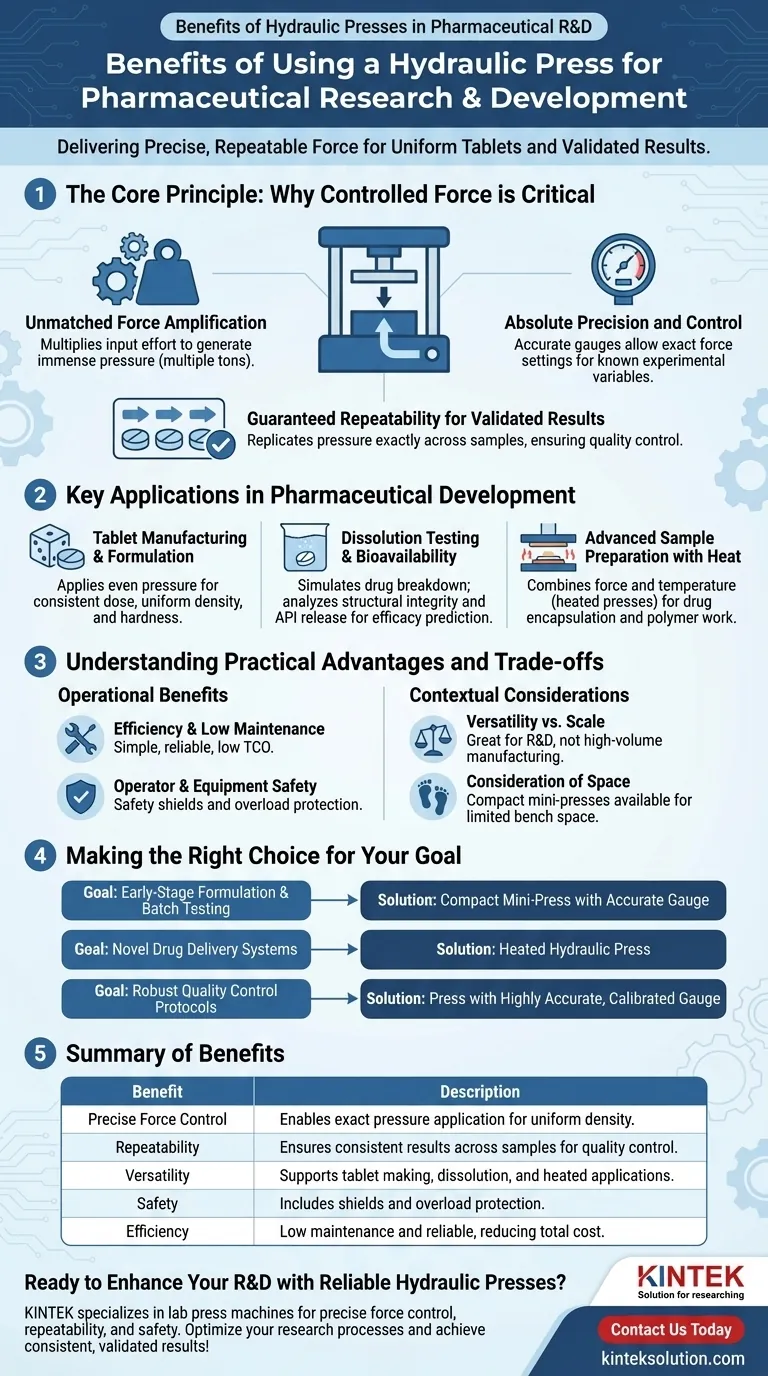
Related Products
- Laboratory Hydraulic Press 2T Lab Pellet Press for KBR FTIR
- Laboratory Hydraulic Press Lab Pellet Press Button Battery Press
- Manual Heated Hydraulic Lab Press with Integrated Hot Plates Hydraulic Press Machine
- Automatic Laboratory Hydraulic Press Lab Pellet Press Machine
- Automatic Laboratory Hydraulic Press for XRF and KBR Pellet Pressing
People Also Ask
- How are hydraulic presses used in spectroscopy and compositional determination? Enhance Accuracy in FTIR and XRF Analysis
- What are the main advantages of using hydraulic presses for sample preparation? Achieve Precise, Uniform Samples for Reliable Analysis
- What is the overall significance of hydraulic presses in laboratories? Unlock Precision and Power for Your Research
- What are the benefits of reduced physical effort and space requirements in hydraulic mini presses? Boost Lab Efficiency and Flexibility
- How is a laboratory hydraulic press used in sample preparation for FTIR spectroscopy? Create Transparent Pellets for Accurate Analysis












